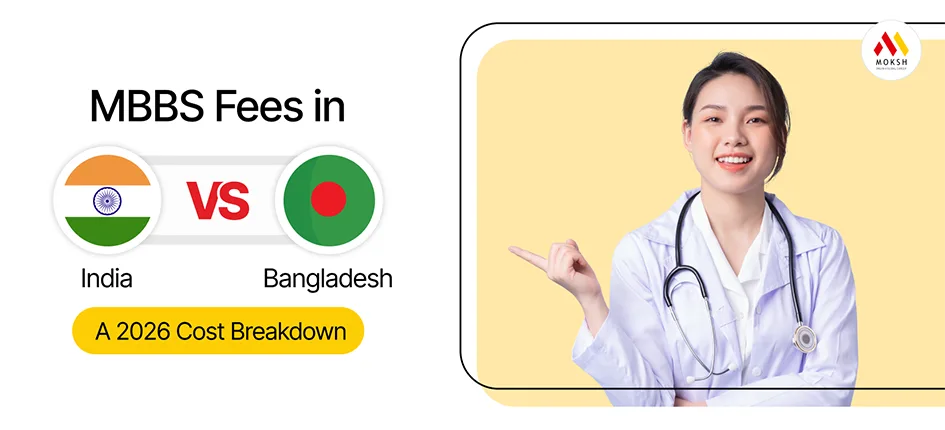
Do you dream of becoming a doctor? If you are an Indian student or a concerned parent, you know the reality. The competition for an affordable MBBS seat in India is incredibly tough. Every year, lakhs of MBBS aspirants compete for a limited number of seats. This makes the journey like a race that is impossible.
But then, are there not other ways? A way to a quality, accepted medical degree, and not one that causes absolute stress and high costs.
That's where we come in. We are MOKSH Overseas Educon, your pleasant guide. We assist Indian students like you to seek intelligent and accepted alternatives to studying MBBS in foreign countries. We think the dream of you wearing a white coat is not far. Let's explore a promising option together.
The Indian MBBS Reality Check - Why Students Look Abroad?
The Two Paths in India
For Indian students, studying MBBS in India feels like two very different roads.
- The Government College Dream: Everyone wants this. The MBBS in India fees are low, maybe Rs. 20,000 to Rs. 1.5 Lakh a year. But there is a huge catch. To get one of these government MBBS seats, you need a super high NEET UG rank, often under 10,000. For most students, this dream is just too hard to reach.
- The Private College Shock: The other road is private colleges. But this one brings a big surprise, a "sticker shock." The private medical college fees are sky-high. They can cost from Rs. 15 to 25 Lakhs every year. For the whole course, the cost of private MBBS can be a massive Rs. 75 Lakh to over Rs. 1.5 Crore.
The Simple Conclusion
This is why so many students and parents feel stuck. The competition is too high, and the private medical college fees are just too expensive. This big financial wall is the main reason families start to look for other options abroad.
MBBS in Bangladesh 2026: A Cost-Effective & Quality Alternative
What if you could study medicine in a place that feels almost like home? MBBS in Bangladesh is a great choice for Indian students. It is right next door, with a similar culture and food. You won't feel too far from home. Best of all, the medical colleges there are NMC approved medical colleges. This means your degree is valid when you return to India to practice.
Great Quality Without the Huge Cost
The best part is the value. You can get a high-quality medical education for a much lower price than at private colleges in India. This makes studying medicine in Bangladesh a very smart decision for your future.
Why It's a Good Education:
- Classes in English: You will learn in English, so there is no new language to learn.
- Globally Recognized: The colleges have WHO recognition, which is respected worldwide.
- Modern Learning: You will train in hospitals and use modern equipment.
Choosing Bangladesh means choosing a clear path to becoming a doctor.
Cost of MBBS in Bangladesh vs. India
It's time to talk numbers. Seeing the real cost breakdown helps you understand why so many families are making this choice. The table below shows a clear head-to-head comparison.
| Cost Component | MBBS in India (Private) | MBBS in Bangladesh |
|---|---|---|
| Tuition Fees (Total Course) | Rs. 50 Lakhs - 1.2 Crore+ | Rs. 20 - 35 Lakhs |
| Hostel & Food Fees (Approx. per year) | Rs. 1 - 2 Lakhs | Rs. 1 - 1.5 Lakhs |
| Other One-Time Charges | Very High (Donation, etc.) | Moderate (Admission, etc.) |
| Total Cost of MBBS (All-Inclusive) | Rs. 75 Lakhs - 1.5 Crore+ | Rs. 25 - 45 Lakhs |
Note: Government MBBS in India costs Rs. 1-7 Lakhs total, but is very hard to get.
The Bottom Line: Massive Savings
The total cost of MBBS is the most important number. The MBBS fees in Bangladesh for 2026 are a fraction of the price of a private college in India.
Choosing Bangladesh for your affordable MBBS degree can save your family tens of millions of rupees. You get a quality education without the lifelong burden of huge debt. This makes your dream of becoming a doctor much more possible.
More Than Just Money: Your Future in Medicine
Your Degree Must Work in India
Saving money is great. But your medical degree must be valid back home. This is the most important thing. All the colleges we work with have NMC recognition. This means your degree allows you to practice in India after you pass the required exam. (It was formerly called MCI recognition).
The Final Exam to Practice in India
To work as a doctor in India, you must pass a licensing test. This is called the FMGE or the new NExT exam. We know this exam is challenging. But you will not be alone. MOKSH provides special FMGE/NExT coaching support throughout your studies to prepare you for this final step.
A Home Away From Home
Your comfort matters. In Bangladesh, you will find cultural similarity and familiar Indian food. It is easy for your family to visit. This makes settling in much smoother, so you can focus on your studies.
MBBS in Bangladesh vs. India: What is the Best Choice for You?
Making your MBBS decision is a big step. Here is simple advice to help you choose the better option for MBBS for your future.
- Choose a Government College in India if you have a very high NEET rank and a low budget. This is the best option, but it is the hardest to get.
- Choose MBBS in Bangladesh if you have a good, but not top, NEET score and a budget of Rs. 25-45 Lakhs. This is the smart cost vs quality choice for most students.
- Only look at Private India colleges if your budget is over Rs. 1 Crore and you must study in India, no matter the cost.
This MBBS abroad advice helps you see the clearest path to your medical degree.
Your Simple Path to MBBS Admission with MOKSH
We know the search for reliable agents for MBBS abroad can be stressful. Some give wrong information. With MOKSH, you get a trusted partner.
How Our MOKSH Services Help You?
We make the MBBS admission process easy. Our education consultancy guides you every step of the way:
- We help you pick the right NMC-approved college.
- We help secure your admission seat.
- We give you full visa help.
- We offer support after you arrive.
Your Next Step is Free
Ready to see your future clearly? Get a Free, Personalized Cost-Benefit Analysis for Your Profile. Consult us now and begin the journey.
Conclusion
MBBS in Bangladesh is a brilliant decision to undertake to pursue a great medical career without spending a fortune. The information is now at your own disposal to make a confident decision in your future.
Call MOKSH Overseas Educon and begin to live an accredited MBBS life.









